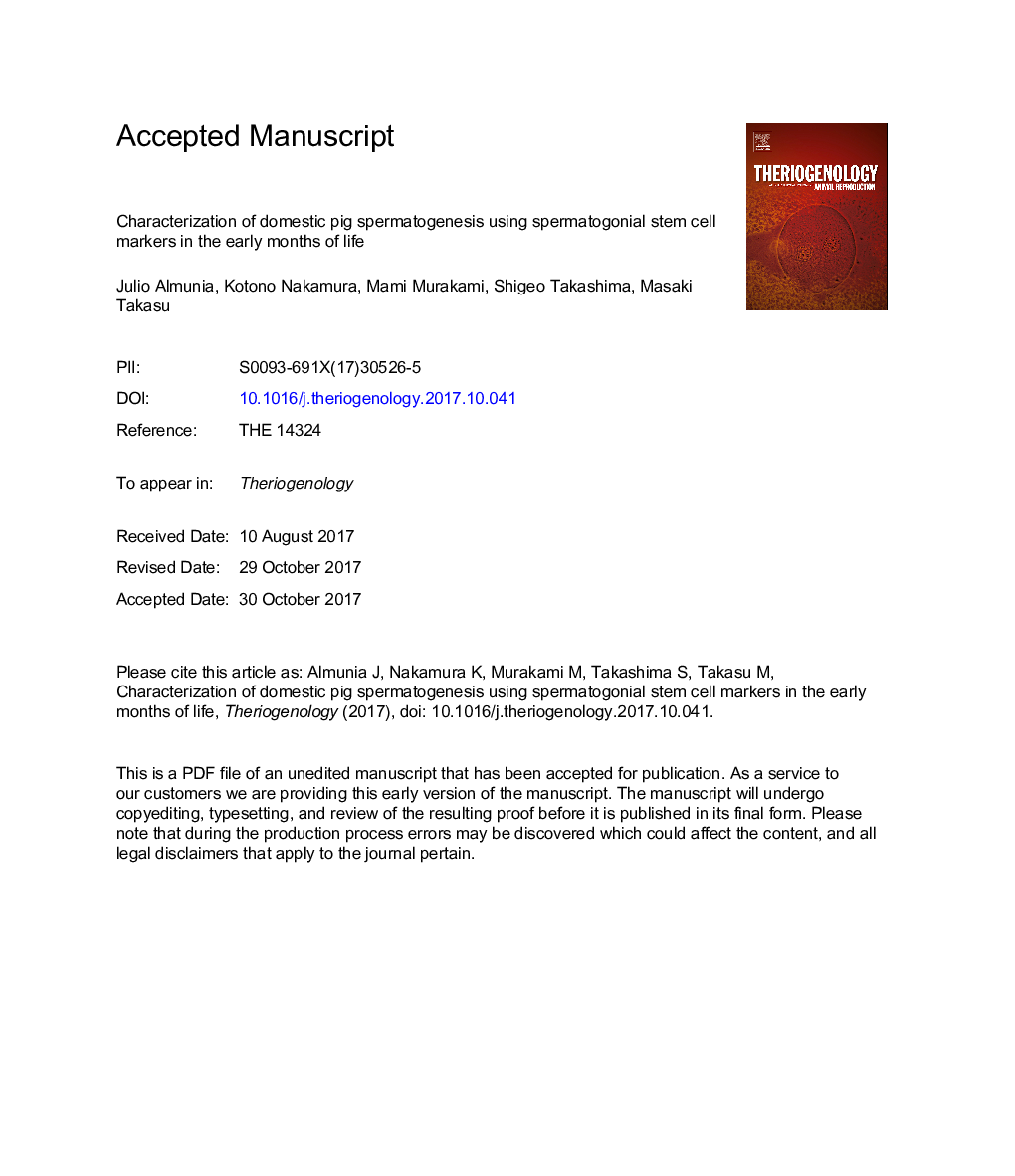| کد مقاله | کد نشریه | سال انتشار | مقاله انگلیسی | نسخه تمام متن |
|---|---|---|---|---|
| 8427718 | 1546062 | 2018 | 28 صفحه PDF | دانلود رایگان |
عنوان انگلیسی مقاله ISI
Characterization of domestic pig spermatogenesis using spermatogonial stem cell markers in the early months of life
ترجمه فارسی عنوان
خصوصیات اسپرماتوژنز خوک های خانگی با استفاده از نشانگرهای سلول های بنیادی اسپرماتوگونی در ماه های اولیه زندگی
دانلود مقاله + سفارش ترجمه
دانلود مقاله ISI انگلیسی
رایگان برای ایرانیان
کلمات کلیدی
خوک، اسپرماتوژنز، سلول های بنیادی اسپرماتوگونال،
موضوعات مرتبط
علوم زیستی و بیوفناوری
علوم کشاورزی و بیولوژیک
علوم دامی و جانورشناسی
چکیده انگلیسی
In pigs, spermatogonial stem cells (SSCs), which include gonocytes and undifferentiated spermatogonia, are classically defined as being present till up to 2 months of life. However, knowledge about this transition from gonocytes to undifferentiated spermatogonia in pigs is limited. In this study, we characterized pig SSCs in neonatal (n = 6), one-month-old (1-mo-old, n = 6), two-month-old (2-mo-old, n = 6), and adult testes (n = 6) anatomically, histologically, and immunohistologically. Anatomically, testicular circumference (TC) was measured at each development stage. Histologically, the presence or absence of seminiferous lumen was confirmed, and seminiferous tubule diameter (SD) was measured. Immunohistologically, changes in expression of pluripotent markers: DBA, UCHL1, ZBTB16, and POU5F1, were evaluated. For the analyses, cells positive for DBA, ZBTB16, UCHL1, and Vimentin per 150 round seminiferous tubules of cross sections from each testis were counted to evaluate the total number of positive cells, and then the positive cells per 100 Sertoli cells (UCHL1+/Sertoli, DBA+/Sertoli, and ZBTB16+/Sertoli) were calculated to compare the four developmental stages. Anatomically, piglet testes became larger with increasing age. Histologically, there was no seminiferous lumen in piglet testes, and only a single layer of cells was observed within the seminiferous tubules. Immunohistologically, the average number of DBA+/Sertoli, which indicates the number of gonocytes, was significant lowerthan that of UCHL1+/Sertoli (P < 0.05), which indicates the number of total SSCs in neonatal testes, suggesting that spermatogenesis had already started at birth. In 2-mo-old testes, although the average number of UCHL1+/Sertoli was the same as that in neonatal and 1-mo-old testes, the average number of DBA+/Sertoli decreased rapidly to an undetectable level. Moreover, the numbers of ZBTB16+/Sertoli and DBA+/Sertoli in neonatal testes were similar, and the number of ZBTB16+/Sertoli in 1-mo-old testes was significantly lower than that of DBA+/Sertoli (P < 0.05). Since ZBTB16 may be a marker for stable gonocytes or spermatogonia, the multiplication of the SSCs in neonatal testes may not be very vigorous, and this may be accelerated around one month of age. Consequently, our study clarified that differentiation of pig SSCs starts during the fetal period; then, transition of SSCs from gonocytes to undifferentiated spermatogonia is accelerated at one month of age and finally completed at two months of age.
ناشر
Database: Elsevier - ScienceDirect (ساینس دایرکت)
Journal: Theriogenology - Volume 107, February 2018, Pages 154-161
Journal: Theriogenology - Volume 107, February 2018, Pages 154-161
نویسندگان
Julio Almunia, Kotono Nakamura, Mami Murakami, Shigeo Takashima, Masaki Takasu,
